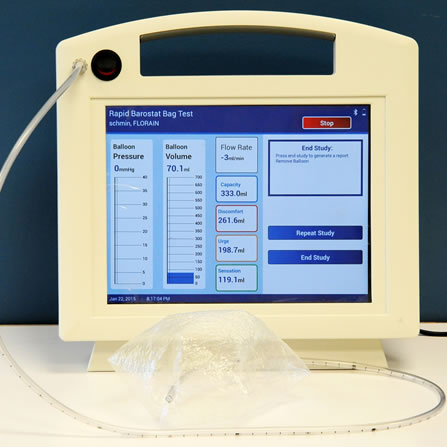As a leading distributor of the Barostat Pump, we are committed to bringing innovative solutions to GI clinics and pelvic floor therapists. Research by Dr. Mark Fox and colleagues underscores the clinical value of barostat technology in assessing rectal function. Here’s a summary of the findings and how the Barostat Pump benefits patients.
Research Summary: What Did the Study Find?
The study by Dr. Fox et al. focused on improving the assessment of rectal compliance (how easily the rectal wall stretches) and rectal capacity (the maximum volume the rectum can hold) using the barostat pump. The research involved healthy volunteers and compared different measurement protocols to validate the reproducibility and clinical relevance of barostat-based assessments.
Key findings include:
- Highly reproducible measurements: Rectal capacity measured at 40 mmHg was consistent across different protocols and days.
- Improved accuracy: Correcting compliance measurements for rectal capacity led to more precise assessments of rectal wall stiffness, independent of the rectum’s size or shape.
- Better symptom correlation: Normalized measurements (expressed as a percentage of rectal capacity) improved the association between measured values and patient sensations (like urgency or pain) and continence performance.
- Functional insights: The barostat pump provided complementary information to traditional compliance measurements, enhancing the understanding of rectal function and continence mechanisms.
How Does the Barostat Pump Benefit Patients?
More Accurate Diagnosis
- The Barostat Pump provides a detailed and objective assessment of rectal function, allowing clinicians to pinpoint whether symptoms are due to changes in rectal wall stiffness, reduced capacity, or abnormal sensitivity.
- This accuracy means patients are less likely to receive misdiagnoses or ineffective treatments, leading to faster relief and better outcomes.
Personalized Treatment Plans
- By accounting for each patient’s unique rectal capacity, clinicians can tailor therapies to individual needs, whether addressing incontinence, constipation, or pain.
- Normalized measurements allow for direct comparison between patients and over time, enabling more responsive and effective care adjustments.
Enhanced Symptom Management
- The barostat pump’s ability to measure both compliance and capacity helps distinguish between different causes of symptoms, such as urgency or leakage, leading to more targeted interventions.
- Patients benefit from therapies that are specifically designed to address their underlying physiological issues, improving quality of life.
Reduced Testing Burden
- With highly reproducible results, patients are less likely to need repeated or unnecessary tests, minimizing discomfort and inconvenience.
Why Should Clinics Invest in the Barostat Pump?
- Clinical Confidence: The Barostat Pump delivers reliable, standardized data, supporting evidence-based decision-making and enhancing clinic reputation.
-
Expanded Capabilities: Clinics can offer advanced diagnostic services for a wide range of anorectal disorders, attracting more referrals and improving patient care.
- Research and Innovation: The reproducibility and normalization features make the Barostat Pump ideal for clinical studies and for developing new protocols in GI and pelvic floor health.
The Barostat Pump is a powerful, research-backed tool that elevates the standard of care for patients with anorectal disorders. By providing accurate, reproducible, and clinically meaningful measurements, it empowers clinicians to deliver personalized, effective treatments—improving outcomes and patient satisfaction at every step.
Got questions? Want to learn more? Get in touch with us today! We’re here to support you with top-quality medical equipment and supplies that help you provide the best patient care possible - sales@minervahealthinc.com or +1 (833) 464-6378.
Fox, M., Thumshirn, M., Fried, M., & Schwizer, W. (2006). Barostat measurement of rectal compliance and capacity. Diseases of the Colon and Rectum, 49(3), 360–370. https://doi.org/10.1007/s10350-005-0295-2



